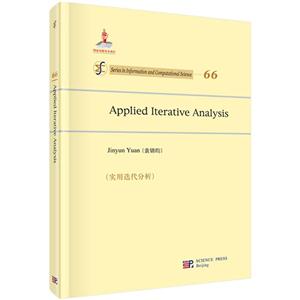预估到手价是按参与促销活动、以最优惠的购买方案计算出的价格(不含优惠券部分),仅供参考,未必等同于实际到手价。
-
>
宇宙、量子和人类心灵
-
>
(精)BBC地球故事系列-星际旅行
-
>
从一到无穷大
-
>
图说相对论(32开平装)
-
>
一本有趣又有料的化学书
-
>
刘薰宇的数学三书:原来数学可以这样学全3册
-
>
光学零件制造工艺学
实用迭代分析 版权信息
- ISBN:9787030420787
- 条形码:9787030420787 ; 978-7-03-042078-7
- 装帧:一般胶版纸
- 册数:暂无
- 重量:暂无
- 所属分类:>>
实用迭代分析 本书特色
袁锦昀教授是杰出的旅居巴西华人1957年出生于江苏兴化唐刘镇,1977年考入南京工学院,巴西巴拉那联邦大学数学系终身教授、工业数学研究所所长,巴西计算和应用数学学会副会长,巴西数学会巴拉那州分会会长,巴西科技部基金委数学终审组应用数学和计算数学负责人,巴西巴拉那基金委数学终身组成员。 《实用迭代分析(英文版)(精)》是由其创作的英文版实用迭代分析专著。
实用迭代分析 内容简介
本书以不同的视角研究了基本迭代法在线性系统中的应用。本书系统的介绍了作者及其团队的在迭代法方面的研究成果。从教学的角度讲本书可以使学生较快较容易地掌握重点和抓住要害。从科研的角度讲,本书给研究者提供了如何获得新思路以及如何做研究的方法。作者还给出了在研究方法方面的研究。为培养研究生的自主科研能力,作者还提到的一些可能出现的问题以及可以用到的研究方法。
实用迭代分析 目录
preface
chapter 1 introduction 1
1.1 background in linear algebra 1
1.1.1 basic symbols, notations, and de.nitions 1
1.1.2 vector norm 2
1.1.3matrix norm 4
1.1.4 spectral radii 8
1.2 spectralresultsofmatrix 10
1.3 specialmatrices 15
1.3.1 reducible and irreducible matrices 15
1.3.2 diagonally dominant matrices 16
1.3.3 nonnegative matrices 20
1.3.4 p-cyclic matrices 22
1.3.5 toeplitz, hankel, cauchy, cauchy-like and hessenberg matrices 24
1.4 matrix decomposition 27
1.4.1 lu decomposition 27
1.4.2 singular value decomposition 28
1.4.3 conjugate decomposition 30
1.4.4 qz decomposition 32
1.4.5 s & t decomposition 33
1.5 exercises 37
chapter 2 basic methods and convergence 40
2.1 basic concepts 40
2.2 the jacobi method 43
2.3 the gauss-seidel method 46
2.4 the sor method 49
2.5 m-matrices and splitting methods 58
2.5.1 m-matrix 58
2.5.2 splitting methods 60
2.5.3 comparison theorems 62
2.5.4 multi-splitting methods 66
2.5.5 generalized ostrowski-reich theorem 67
2.6 error analysis of iterative methods 69
27 iterative re.nement 70
2.8 exercises 75
chapter 3 non-stationary methods 78
3.1 conjugategradientmethods 79
3.1.1 steepest descent method 79
3.1.2 conjugate gradient method 80
3.1.3 preconditioned conjugate gradient method 83
3.1.4 generalized conjugate gradient method 85
3.1.5 theoretical results on the conjugate gradient method 85
3.1.6 generalized product-type methods based on bi-cg 91
3.1.7 inexact preconditioned conjugate gradient method 92
3.2 lanczos method 93
3.3 gmres method and qmr method 95
3.3.1 gmres method 95
3.3.2 qmr method 98
3.3.3 variants of the qmr method 100
3.4 direct projection method 101
3.4.1 theory of the direct projection method 102
3.4.2 direct projection algorithms 105
3.5 semi-conjugate direction method 107
3.5.1 semi-conjugate vectors 107
3.5.2 left conjugate direction method 110
3.5.3 one possible way to .nd left conjugate vector set 112
3.5.4 remedy for breakdown 117
3.5.5 relation with gaussian elimination 119
3.6 krylov subspace methods 121
3.7 exercises 122
chapter 4 iterative methods for least squares problems 126
4.1 introduction 126
4.2 basic iterative methods 128
4.3 blocksor methods 131
4.3.1 block sor algorithms 131
4.3.2 convergence and optimal factors 132
4.3.3 example 135
4.4 preconditioned conjugate gradient methods 136
4.5 generalized least squares problems 138
4.5.1 block sor methods 139
4.5.2 preconditioned conjugate gradient method 142
4.5.3 comparison 143
4.5.4 sor-like methods 144
4.6 rank de.cient problems 148
4.6.1 augmented system of normal equation 149
4.6.2 block sor algorithms 150
4.6.3 convergence and optimal factor 151
4.6.4 preconditioned conjugate gradient method 154
4.6.5 comparison results 158
4.7 exercises 161
chapter 5 preconditioners 163
5.1 lu decomposition and orthogonal transformations 164
5.1.1 gilbert and peierls algorithm for lu decomposition 164
5.1.2 orthogonal transformations 166
5.2 stationary preconditioners 167
5.2.1 jacobi preconditioner 167
5.2.2 ssor preconditioner 168
5.3 incompletefactorization 169
5.3.1 point incomplete factorization 170
5.3.2 modi.ed incomplete factorization 172
5.3.3 block incomplete factorization 172
5.4 diagonally dominant preconditioner 173
5.5 preconditionerforleastsquaresproblems 177
5.5.1 preconditioner by lu decomposition 179
5.5.2 preconditioner by direct projection method 181
5.5.3 preconditioner by qr decomposition 182
5.6 exercises 186
chapter 6 singular linear systems 188
6.1 introduction 188
6.2 properties of singular systems 191
6.3 splittingmethodsforsingularsystems 195
6.4 nonstationarymethodsforsingularsystems 219
6.4.1 symmetric and positive semide.nite systems 219
6.4.2 general systems 222
6.5 exercises 225
bibliography 228
index 249
《信息与计算科学丛书》 253
- >
罗曼·罗兰读书随笔-精装
罗曼·罗兰读书随笔-精装
¥40.6¥58.0 - >
伊索寓言-世界文学名著典藏-全译本
伊索寓言-世界文学名著典藏-全译本
¥6.1¥19.0 - >
小考拉的故事-套装共3册
小考拉的故事-套装共3册
¥36.7¥68.0 - >
企鹅口袋书系列·伟大的思想20:论自然选择(英汉双语)
企鹅口袋书系列·伟大的思想20:论自然选择(英汉双语)
¥6.3¥14.0 - >
自卑与超越
自卑与超越
¥17.1¥39.8 - >
上帝之肋:男人的真实旅程
上帝之肋:男人的真实旅程
¥19.3¥35.0 - >
回忆爱玛侬
回忆爱玛侬
¥10.5¥32.8 - >
随园食单
随园食单
¥20.6¥48.0
-
矩阵论
¥9.5¥28 -
高等代数专题研究学习指导书
¥5.9¥12 -
2022图书×抽奖盲袋
¥9.9¥25 -
2023读书月阅读盲盒——天黑,闭眼,刀谁?
¥42.3¥158 -
2022读者节纪念徽章-三星会员专属
¥45¥45.6



















